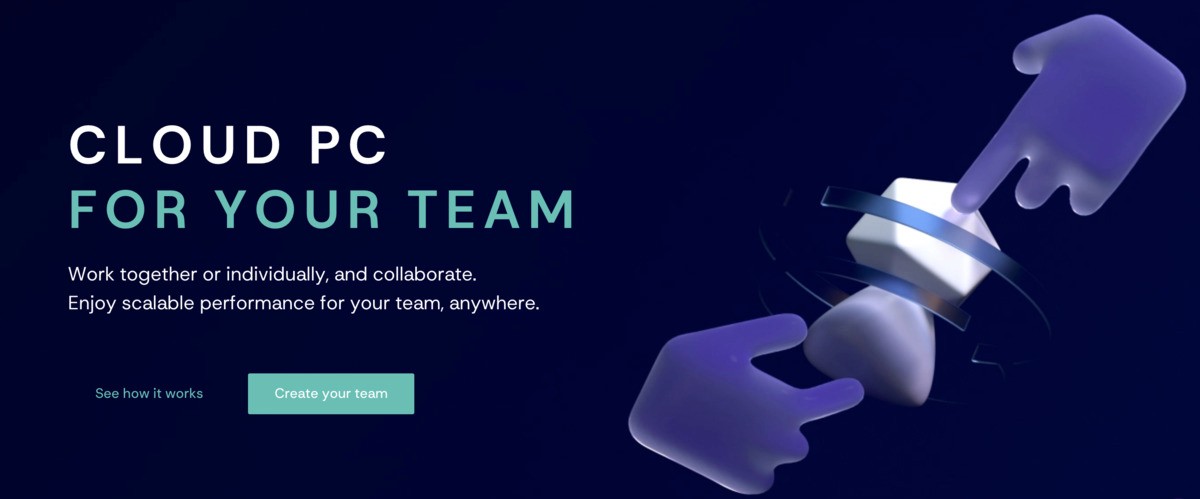Instant Connection for Pixel Streaming
— New Feature Automated Setup





Fundamentals of Working Remotely & Collaboration Suggestions
Fundamentals of Working Remotely & Collaboration Suggestions
Fundamentals of Working Remotely & Collaboration Suggestions
Published on May 29, 2023
Table of Contents
Remote working is an agile way of working that allows employees and collaborators to work from anywhere, without having to go to the office. It should be remembered that “agile working” should not be considered a working tool to be implemented only in exceptional cases, but constitutes - to all intents and purposes - a working method comparable to that performed by those who go to the office.
Remote working is based on the principles of autonomy and flexibility of time and space. It’s therefore essential that companies, when they decide to apply it, are also able to manage it in the best way to obtain returns in terms of performance and remote work productivity.
From this point of view, it’s, in part, the responsibility of the company to encourage video calls between colleagues, encouraging them to collaborate to achieve the pre-established common results. To do this, first of all, it’s essential to provide all the tools for employees to collaborate, including video calling software, screen sharing and, in some cases, provide high-performance computers.

Photo by Hannah Wei on Unsplash
Collaboration when Working from Home
In remote working, collaboration is essential because it allows you to:
Achieve goals, making the team more productive;
Avoid social isolation, one of the major risks of this way of working;
Facilitate the creation of professional relationships between colleagues;
Encourage the expression of one’s ideas.
Once the potential of remote working has been clarified, it’s advisable to dwell on the tools to be used, remembering that their main purpose is to encourage communication and exchange between individual members of the group. The actions to be implemented to facilitate the virtual collaboration are:
Simplification of communications, favoring real-time conversations to manage projects, for example through common chats;
Organization of virtual team-building and meetings;
Cloud document management;
Planner and appointments managed through a shared calendar.
Best Practices of Remote Work
Collaboration tools cover a wide range of activities, from messaging tools, chats, video conferences, training/learning platforms, interactive screen sharing, virtual whiteboards, calendar management, mail management, and file sharing. Choosing a set of tools rather than another depends on your needs and field; creative agencies will use different tools than financial institutions.
Applications are now centrally located in a shared cloud, accessible from anywhere on a 24/7 basis, as long as you are granted the right credentials you’ll have access to the main interface and all the tools that are available to you as a user.
From the moment an employee logins in the morning, everything should be clear, convenient, and at hand. From high-priority operations for the day to updates on current projects, scheduled meetings for the day, etc. There shouldn’t be any “gap” in the platform between this interface and the applications or tools they’ll need to perform it.
Of great importance is the training of employees, as otherwise they’ll not collaborate effectively (generating frustration and loss of productivity) and/or will not exploit this digital remote working platform to its full potential.
The collaboration with the IT department is extremely valuable and it should be an ongoing conversation to optimize and streamline the remote work and keep the costs within budget.

Photo by Chris Montgomery on Unsplash
Security while Collaborating Online
Remote working considerably increases the traffic on the network and the consequent risk of attack by cybercriminals. Collaboration platforms are particularly exposed to this type of risk, considering how many humans (with all their errors) are working from perhaps not overly secure wifi networks (airports, coffee places, beach hostels…), theft of credentials, and data leaks everyday news.
Two things can be done to limit (not eliminate) these risks. Firstly, strict access and authentication policies should be able to cut out any unauthorized users and/or devices, encourage employees to change often their passwords, and require MFA (multi-factor authentication) system as a required step to obtain access to the virtual collaboration platform.
Secondly, regardless of any tech solution, training personnel in good IT hygiene practices it’s one of the best things you can do for your company, doesn’t matter how much it can cost, it’s worth it! It is the first and most important step to take for a company that intends to face cybersecurity seriously.
Resource Management
The principles of autonomy, flexibility, and freedom at the basis of remote working necessarily lead to an evolution in employee management models. In defining remote team management, it’s essential to respect some aspects:
Workload: it’s essential to organize work times to avoid overwork and the loss of distinction between work and private life;
Conscious use of tools: use of technological communication tools favors interaction and allows monitoring of activities;
Ability to delegate: this is a fundamental concept in employee management, based on trust between employer or manager and subordinate.
In the context of remote working, the challenge posed today to human resources is to be able to enhance the interpersonal relationship, motivate, stimulate, and encourage the involvement of the worker, despite this taking place through a screen. Human value must be placed at the center of the corporate development process, this is increasingly hindered by the digitized management of the employee.
Trust is the Foundation of Remote Work
Remote working requires an organizational and managerial change compared to the traditional work model. The transition from a work control system to a context based on the principles of freedom and autonomy is significant. This change, therefore, requires an evolution in the relationship between the company and employees based on trust.
The non-physical presence of the worker in the office and the impossibility of visual inspection necessarily imply that we rely on his/her professionalism and conscientiousness in carrying out tasks and duties. A relationship of trust between employee and manager is crucial for smart working to be applied: in fact, what matters is not where, how, and when, but the results achieved by the employee.
The remote work culture requires a deep shift in the managerial philosophy and the employees’ management. A multidisciplinary vision that promotes the values of collaboration, responsibility, and trust, while respecting the worker’s autonomy.
With this in mind, Vagon developed a way for you to collaborate with your team literally from anywhere and on any device thanks to what we like to call a supercomputers on the cloud:
Vagon Teams offers you an easy-to-adapt cloud solution that completely cuts all your dependency on hardware. As this high-performance cloud computer grows with the number of your team members, freelance and remote work matches perfectly with this flexible high-performance cloud computer.

Remote working is an agile way of working that allows employees and collaborators to work from anywhere, without having to go to the office. It should be remembered that “agile working” should not be considered a working tool to be implemented only in exceptional cases, but constitutes - to all intents and purposes - a working method comparable to that performed by those who go to the office.
Remote working is based on the principles of autonomy and flexibility of time and space. It’s therefore essential that companies, when they decide to apply it, are also able to manage it in the best way to obtain returns in terms of performance and remote work productivity.
From this point of view, it’s, in part, the responsibility of the company to encourage video calls between colleagues, encouraging them to collaborate to achieve the pre-established common results. To do this, first of all, it’s essential to provide all the tools for employees to collaborate, including video calling software, screen sharing and, in some cases, provide high-performance computers.

Photo by Hannah Wei on Unsplash
Collaboration when Working from Home
In remote working, collaboration is essential because it allows you to:
Achieve goals, making the team more productive;
Avoid social isolation, one of the major risks of this way of working;
Facilitate the creation of professional relationships between colleagues;
Encourage the expression of one’s ideas.
Once the potential of remote working has been clarified, it’s advisable to dwell on the tools to be used, remembering that their main purpose is to encourage communication and exchange between individual members of the group. The actions to be implemented to facilitate the virtual collaboration are:
Simplification of communications, favoring real-time conversations to manage projects, for example through common chats;
Organization of virtual team-building and meetings;
Cloud document management;
Planner and appointments managed through a shared calendar.
Best Practices of Remote Work
Collaboration tools cover a wide range of activities, from messaging tools, chats, video conferences, training/learning platforms, interactive screen sharing, virtual whiteboards, calendar management, mail management, and file sharing. Choosing a set of tools rather than another depends on your needs and field; creative agencies will use different tools than financial institutions.
Applications are now centrally located in a shared cloud, accessible from anywhere on a 24/7 basis, as long as you are granted the right credentials you’ll have access to the main interface and all the tools that are available to you as a user.
From the moment an employee logins in the morning, everything should be clear, convenient, and at hand. From high-priority operations for the day to updates on current projects, scheduled meetings for the day, etc. There shouldn’t be any “gap” in the platform between this interface and the applications or tools they’ll need to perform it.
Of great importance is the training of employees, as otherwise they’ll not collaborate effectively (generating frustration and loss of productivity) and/or will not exploit this digital remote working platform to its full potential.
The collaboration with the IT department is extremely valuable and it should be an ongoing conversation to optimize and streamline the remote work and keep the costs within budget.

Photo by Chris Montgomery on Unsplash
Security while Collaborating Online
Remote working considerably increases the traffic on the network and the consequent risk of attack by cybercriminals. Collaboration platforms are particularly exposed to this type of risk, considering how many humans (with all their errors) are working from perhaps not overly secure wifi networks (airports, coffee places, beach hostels…), theft of credentials, and data leaks everyday news.
Two things can be done to limit (not eliminate) these risks. Firstly, strict access and authentication policies should be able to cut out any unauthorized users and/or devices, encourage employees to change often their passwords, and require MFA (multi-factor authentication) system as a required step to obtain access to the virtual collaboration platform.
Secondly, regardless of any tech solution, training personnel in good IT hygiene practices it’s one of the best things you can do for your company, doesn’t matter how much it can cost, it’s worth it! It is the first and most important step to take for a company that intends to face cybersecurity seriously.
Resource Management
The principles of autonomy, flexibility, and freedom at the basis of remote working necessarily lead to an evolution in employee management models. In defining remote team management, it’s essential to respect some aspects:
Workload: it’s essential to organize work times to avoid overwork and the loss of distinction between work and private life;
Conscious use of tools: use of technological communication tools favors interaction and allows monitoring of activities;
Ability to delegate: this is a fundamental concept in employee management, based on trust between employer or manager and subordinate.
In the context of remote working, the challenge posed today to human resources is to be able to enhance the interpersonal relationship, motivate, stimulate, and encourage the involvement of the worker, despite this taking place through a screen. Human value must be placed at the center of the corporate development process, this is increasingly hindered by the digitized management of the employee.
Trust is the Foundation of Remote Work
Remote working requires an organizational and managerial change compared to the traditional work model. The transition from a work control system to a context based on the principles of freedom and autonomy is significant. This change, therefore, requires an evolution in the relationship between the company and employees based on trust.
The non-physical presence of the worker in the office and the impossibility of visual inspection necessarily imply that we rely on his/her professionalism and conscientiousness in carrying out tasks and duties. A relationship of trust between employee and manager is crucial for smart working to be applied: in fact, what matters is not where, how, and when, but the results achieved by the employee.
The remote work culture requires a deep shift in the managerial philosophy and the employees’ management. A multidisciplinary vision that promotes the values of collaboration, responsibility, and trust, while respecting the worker’s autonomy.
With this in mind, Vagon developed a way for you to collaborate with your team literally from anywhere and on any device thanks to what we like to call a supercomputers on the cloud:
Vagon Teams offers you an easy-to-adapt cloud solution that completely cuts all your dependency on hardware. As this high-performance cloud computer grows with the number of your team members, freelance and remote work matches perfectly with this flexible high-performance cloud computer.

Scalable Remote Desktop for your Team
Create cloud computers for your Team, manage their access & permissions in real-time. Start in minutes & scale.

Trial includes 1 hour usage + 7 days of
storage for first 2 seats.
Scalable Remote Desktop for your Team
Create cloud computers for your Team, manage their access & permissions in real-time. Start in minutes & scale.

Trial includes 1 hour usage + 7 days of
storage for first 2 seats.
Scalable Remote Desktop for your Team
Create cloud computers for your Team, manage their access & permissions in real-time. Start in minutes & scale.
Trial includes 1 hour usage + 7 days of
storage for first 2 seats.
Scalable Remote Desktop for your Team
Create cloud computers for your Team, manage their access & permissions in real-time. Start in minutes & scale.
Trial includes 1 hour usage + 7 days of
storage for first 2 seats.
Scalable Remote Desktop for your Team
Create cloud computers for your Team, manage their access & permissions in real-time. Start in minutes & scale.

Trial includes 1 hour usage + 7 days of
storage for first 2 seats.

Ready to focus on your creativity?
Vagon gives you the ability to create & render projects, collaborate, and stream applications with the power of the best hardware.

Vagon Blog
Run heavy applications on any device with
your personal computer on the cloud.
San Francisco, California
Solutions
Vagon Teams
Vagon Streams
Use Cases
Resources
Vagon Blog
How To Run Unreal Engine on a Low-End Device (Even Without GPU)
How To Run Unity 3D On Low-End Laptop (Even Without GPU)
Best Digital Twin Platforms & Software in 2025
How To Run Cinema 4D On Cloud
The Best PC Build For Unity
Picking The Best GPU For Unreal Engine
DJI Terra vs. Agisoft Metashape: Which One Should You Choose?
How To Run SketchUp On Cloud
How To Use Revit On Cloud Computer
Vagon Blog
Run heavy applications on any device with
your personal computer on the cloud.
San Francisco, California
Solutions
Vagon Teams
Vagon Streams
Use Cases
Resources
Vagon Blog
How To Run Unreal Engine on a Low-End Device (Even Without GPU)
How To Run Unity 3D On Low-End Laptop (Even Without GPU)
Best Digital Twin Platforms & Software in 2025
How To Run Cinema 4D On Cloud
The Best PC Build For Unity
Picking The Best GPU For Unreal Engine
DJI Terra vs. Agisoft Metashape: Which One Should You Choose?
How To Run SketchUp On Cloud
How To Use Revit On Cloud Computer
Vagon Blog
Run heavy applications on any device with
your personal computer on the cloud.
San Francisco, California
Solutions
Vagon Teams
Vagon Streams
Use Cases
Resources
Vagon Blog
How To Run Unreal Engine on a Low-End Device (Even Without GPU)
How To Run Unity 3D On Low-End Laptop (Even Without GPU)
Best Digital Twin Platforms & Software in 2025
How To Run Cinema 4D On Cloud
The Best PC Build For Unity
Picking The Best GPU For Unreal Engine
DJI Terra vs. Agisoft Metashape: Which One Should You Choose?
How To Run SketchUp On Cloud
How To Use Revit On Cloud Computer
Vagon Blog
Run heavy applications on any device with
your personal computer on the cloud.
San Francisco, California
Solutions
Vagon Teams
Vagon Streams
Use Cases
Resources
Vagon Blog



